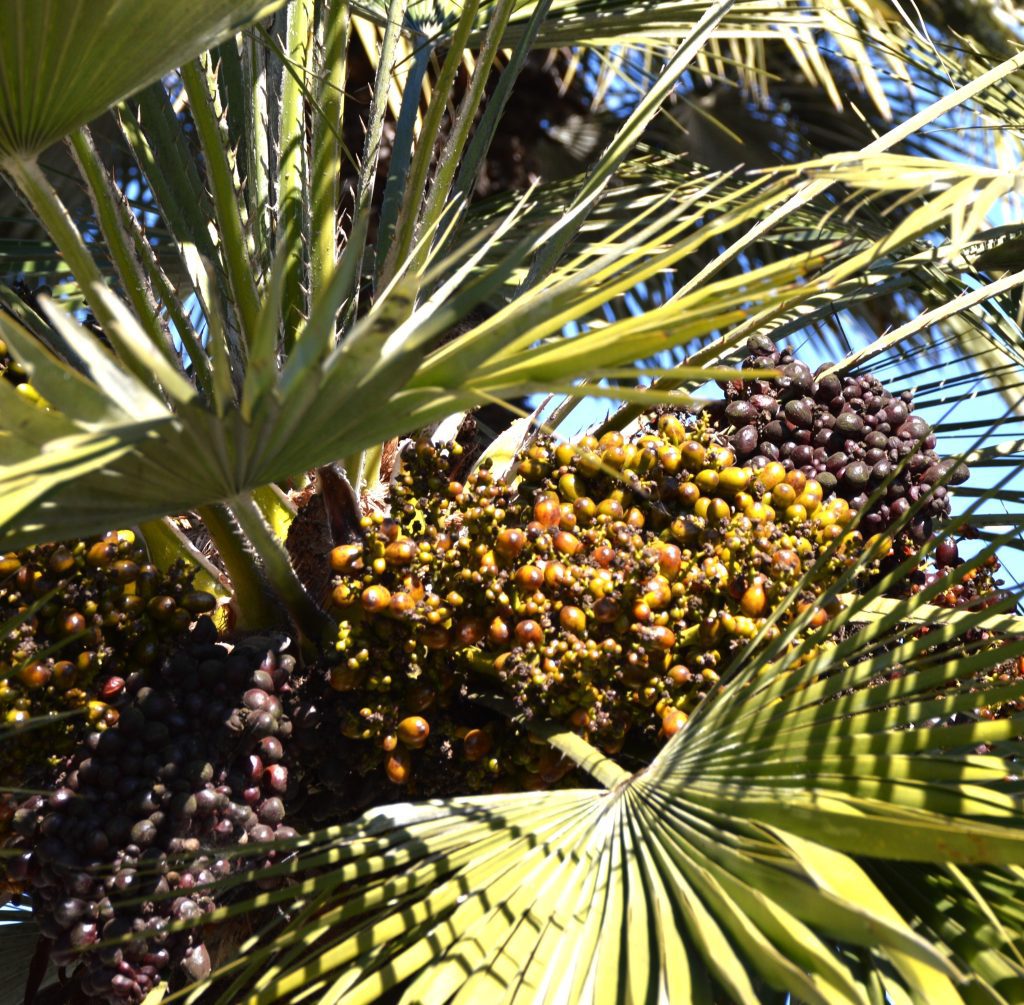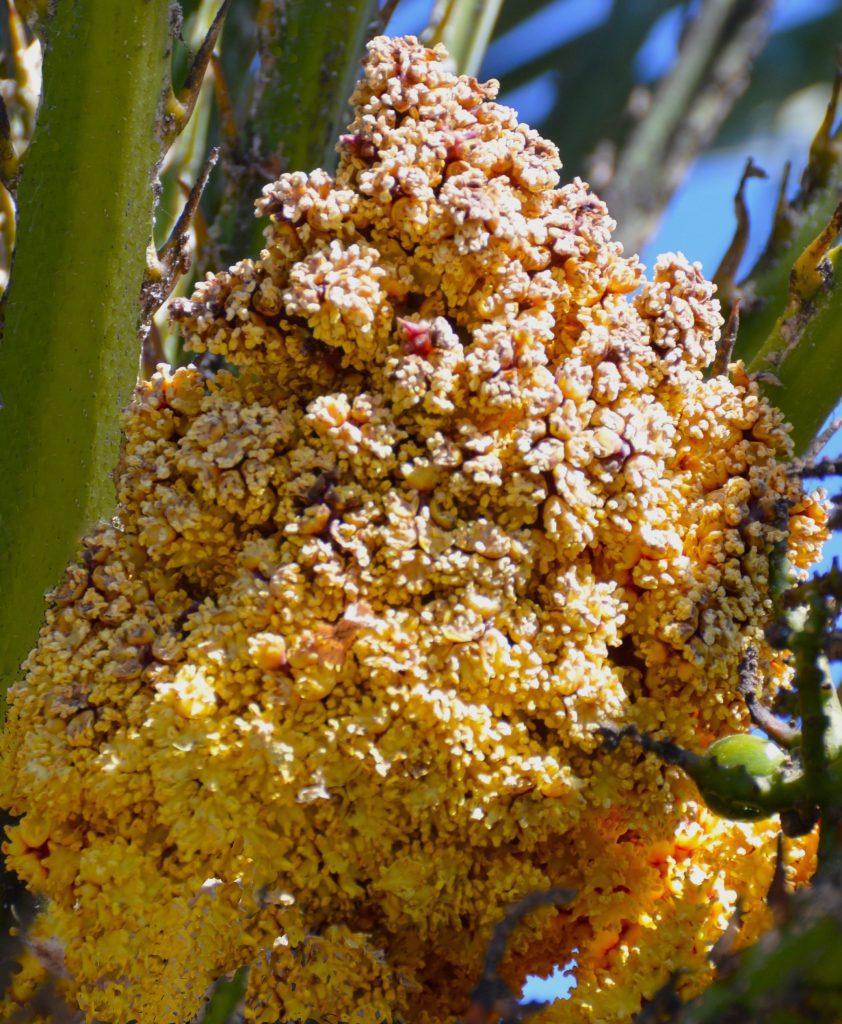Chamaerops humilis
The Mediterranean Fan Palm is extremely hardy, versatile, sustainable, and low maintenance, making it one of the most commonly cultivated palms in our community. It is always a stunning specimen, whether in a classic Mediterranean landscape, in raised planters, or in large containers. As a prized ornamental, it has earned the prestigious Royal Horticultural Society‘s Award of Garden Merit.
It is very drought-tolerant and can survive temperatures above 115 degrees F; it is also remarkably cold-tolerant and can sustain temperatures as low as 10 degrees F. Consequently, it can be used in all the microclimates in Santa Barbara County, from cold creek areas to hot foothills. It seems to tolerate all types of soils. This hardiness explains why it has been planted extensively in our area since the mid- to late-1800s. Its versatility is exhibited by its natural shrub-like appearance bearing multiple trunks, which can be pruned to leave as many trunks as desired or reduced to a single trunk.
The Mediterranean Fan Palm is generally a slow-growing palm. However, individuals can vary greatly in growth habit and color – some slow-growing with compact glaucous (bluish-gray) leaves – and others faster-growing with green leaves. At maturity, it can reach only 10- to 20-feet in height.

Its palmately compound (fan shaped) fronds are rather stiff and can grow to 4-feet-long and 2½-feet-wide. Each frond is deeply segmented, almost to the petiole (frond stem), into 10 to 20 segments. The petioles can be up to 2-feet-long and 1½-inches-wide; these are well-armed, bearing on their margins 1-inch-long spines angled outward toward the leaf blade. Fair warning: the spines are extremely sharp – extra care is required during pruning!
From November to February, dense clusters of small bright-yellow flowers emerge from within the foliage near the tops of the trunks. Each flower cluster, called a “panicle”, is 8- to 12-inches-long and can contain hundreds of small three-lobed flowers. The flowers are both wind-pollinated and insect-pollinated. Like many other palms, the Mediterranean Fan Palms are primarily “dioecious” – meaning they have genders – where male and female flowers only appear on separate palms.
After the female flowers are pollinated, the palm fruits develop in clumps of drupes (a drupe contains one seed inside a fleshy cover); each drupe is oval and ½- to 1-inch long. The new fruit is green – turning to bright reddish-yellow – and then to dark brown, when ripe in September to November. Each fruit contains a dark brown, oval, ½-inch- long palm nut with a hard shell that contains inside a small round seed. Ripe fruits resemble a bunch of tasty grapes – but are not edible.

As its name implies, the Mediterranean Fan Palm is native to the countries bordering the western Mediterranean Sea, including Portugal, Spain, France, Italy, Libya, Tunisia, Algeria, and Morocco. Being the only palm native to the European mainland, its other common name is, not surprisingly, the “European Fan Palm”.
It does have the distinction of being the most northernly naturally occurring of all palms – and has been cultivated as far north as southern England and Vancouver, British Columbia. It is primarily found in coastal regions; however, the variety native to northern Africa, known as the “Atlas Mountain Palm”, can be found growing at elevations up to 6,000 feet in the Great Atlas Mountains of Algeria and Morocco.
The botanical name for the Mediterranean Fan Palm is Chamaerops humilis. The genus name, Chamaerops, is derived from a combination of the Greek words chamai, meaning “dwarf”, and rhops, meaning “bush”. The specific epithet, humilis, comes from the Latin word, humilitas, meaning “dwarf” or “low”.
The Mediterranean Fan Palm is the only species in the genus Chamaerops; however, there are several subspecies and cultivars of the species. C. humilis var. argentea, native to Northwest Africa, has leaves that are strongly glaucous with a silvery-blue coating; C. humilis var. epondraes, native to Northwest Africa, has somewhat glaucous leaves; and C. humilis var. humilis, native to Southwest Europe, has green leaves.
From these varieties, many cultivars have been selected for their distinctive ornamental properties and growth habits. Three of the most popular are C. humilis ‘Nana’, selected for its slow compact growth habit; C. humilis ‘Vulcano’, selected for being compact and thornless with silvery leaves and a thicker growth habit; and C. humilis ‘Stella’, selected for its silvery-blue foliage.
The Mediterranean Fan Palm is easy to grow and has few problems. It does best in full sun to partial shade. It is not particular regarding soil types – but prefers loam soil with good drainage. It can tolerate severe drought – but looks better with occasional deep watering during the dry season. It will grow better if given a slow-release palm fertilizer applied in both the spring and the fall, following package instructions. Pruning can be limited to the removal of dead or discolored fronds and the removal of young root shoots (pups) as desired.
While it is not affected by serious insect or disease problems, it can be infested with common pests like mealybugs, mites, and scale; these can be treated with neem oil and insecticidal soaps.
Mediterranean Fan Palms can be propagated from seed – or vegetatively, by removing pups at the base of the tree. If you want a clone of a named variety, you must use the pups from the cultivar. For seed propagation, lightly cover the seeds and keep them moist until germination – this can take several weeks to a month or more.
The Mediterranean Fan Palm has graced our community since its introduction here over 150 years ago – and is an integral and admired part of our landscapes. Its usefulness as a sustainable ornamental plant will certainly ensure its continued presence in our public parks, our streets, and our private gardens.
Mature Mediterranean Fan Palms can be seen in many locations around town: in East and West Alameda Parks; in Alice Keck Park Memorial Garden; at the County Administration building (on the Anapamu Street side); at the Cabrillo Pavilion Arts Center; at Leadbetter Beach; in the 800 to 1200 blocks of State Street; in the Santa Barbara Cemetery; in Storke Placita; on Coromar Drive in Goleta; and, on the UCSB campus.
Tree-of-the-Month articles are sponsored by Santa Barbara Beautiful, whose many missions include the increase of public awareness and appreciation of Santa Barbara’s many outstanding trees and, in a long-time partnership with the City Parks & Recreation Department, the funding and planting of trees along the City’s streets.
Those who wish to honor a special someone can do so with an attractive commemorative marker that will be installed at the base of an existing street tree in the City of Santa Barbara. Because Santa Barbara Beautiful has participated in the planting to date of over 13,000 street trees, there are plenty of trees from which to choose! Application forms are available on the Santa Barbara Beautiful website, www.sbbeautiful.org.
Article and Photos by David Gress















